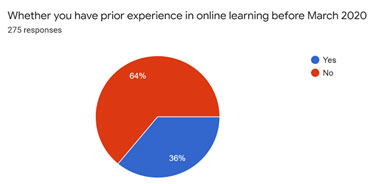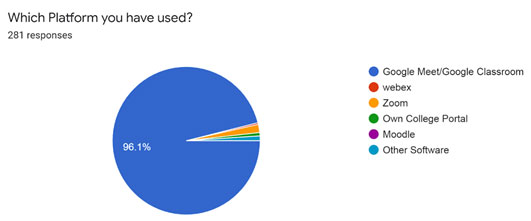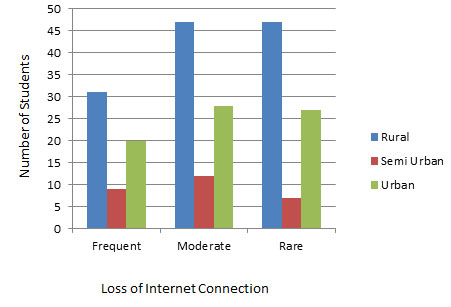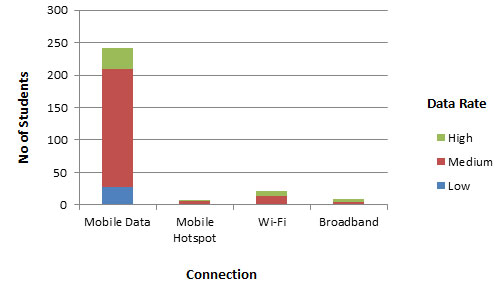Department of Computer Science, Bankura Sammilani College, West Bengal, India.
Corresponding author email: tapas.bsc38@gmail.com
Article Publishing History
Received: 10/11/2021
Accepted After Revision: 12/03/2022
The Pandemic from the Corona Virus (SARS-CoV-2) has impacted the worldwide Education Sector tremendously. Due to it educational institutes across the state of West Bengal have been closed since March-2020. The Pandemic forced the educational community in West Bengalto shift their teaching-learning activities to online platforms.Teachers and students quickly adapted to synchronous i.e. interactive online classes along with asynchronous i.e. video-and other materials-based modes of teaching learning. Various online education platforms and facilitating tools are used heavily during this crisis period.
This survey paper aims to get a detail report on the perception and preferences for different online teaching-learning parameters used by UG level learnersof different general degree colleges along with colleges of professional courses like BBA/BCA and engineering colleges fromthe districts of Bankura and Purulia of West Bengal.The students preference for different attributes of online learningmay be useful for designinga suitable online class environment.A survey work was done in online mode using google form.
The form was circulated among several WhatsApp group of students of different colleges through their teachers.The result showed that almost 96% of thestudents prefer to use Google Meet or Google classroom with their smart phone for online classes. It was also observed that frequent loss of Internet connection in rural areas is moreprominent thanin the Urban and Semi Urban areas of South Bengal.Students preference has utmost importance to attract them for attending online classes. This article will be helpful to attract students in online classes in this crisis period.
Asynchronous Learning,Information and Communication Technology,
Internet,Online Learning, Synchronous Learning.
Ghosh T. K. Department of Computer Science, Bankura Sammilani College, West Bengal, India. Biosc.Biotech.Res.Comm. 2022;15(1).
Ghosh T. K. Department of Computer Science, Bankura Sammilani College, West Bengal, India. Biosc.Biotech.Res.Comm. 2022;15(1). Available from: <a href=”https://bit.ly/3C4GytF“>https://bit.ly/3C4GytF</a>
Copyright © This is an Open Access Article distributed under the Terms of the Creative Commons Attribution License (CC-BY). https://creativecommons.org/licenses/by/4.0/, which permits unrestricted use distribution and reproduction in any medium, provided the original author and sources are credited.
INTRODUCTION
First reported case ofthe Covid-19 disease was in December 2019 in China’s city Wuhan. Due to its highly contagious nature this disease spreads all over the world.Governments of different countries have advised their people for frequent hand washing, wearing masks, maintaining safe distance, and to avoid gathering in a small area.
To control the transmission of the Covid-19 virus lockdown and stay at home have become the only solution to flatten the curve (Sintema2020). The lockdown in response to COVID-19 have interrupted conventional education system. Many countries across the globe have to close their educational institutes to protect their students from viral exposures. The educational community of different countries were forced to make collected efforts to maintain learning continuity during this period (Khan et al. 2021).
In this context online learning has become inevitable in our country also.Students have to depend more on their own devices to continue learning through the Internet from their home. Teachers were also learning new online teaching concepts for which they may not have prior experience.E-learning hasmany advantages like easily accessible, affordable, flexible, life-long learning,learning anytime from anywhere etc.
Online learning is assumed to be easily accessible andit can even reach to rural as well as remote areas.It is also a relatively low cost mode of education in terms of the cost of transportation,accommodation, and the total cost of institutional learning.Technology enabled online lectures are necessary for blended mode of learning and flipped classrooms(Khan et al. 2021).
The flipped classroom is a simple conceptof e-learning where students are provided learning resources such as articles, pre-recorded videos and YouTube links at home and practice working through it. Then the students can use their online classroom time forclearing doubts through discussion with faculty and friends (Doucet et al. 2020). Students can enhance their skills like problemsolving, critical thinking and self learningthrough it.They can learn anytime from anywhere, and thereby becomeable to develop new skills.
The outbreak of Covid-19 Pandemic again adds one more logic favouring online learning.Several researchers had investigated for different class ofstudents’ perception and preferencesfor onlinelearning during the Covid-19 outbreak, and many of them had discussed about the challenges faced. For example, found that online classes are more difficult to manage than traditional face to faceinteractive classroom for the agricultural graduates from different universities of National Agricultural Research System (NARS) in India.This is due to the technical constraints, delay in feedback and incompetency of the instructor to handle effectively the Information and Communication Technologies (Muthuprasadet al. 2021).
Similarly,previous research has shown thatIndian undergraduate medical students have lowest preference for both synchronous and asynchronous learning methods due to poor internet connection speed(Mondal et al. 2021).Also, Dhawan(2020)has reported that factors like security features, speed of Internet, availability of bandwidth, digital literacy levels of the learners etc affect the choice of a particular technology.
Findings of another study Mandal and Mondal (2020) reported that 21% students from districts of Bankura and Purulia of West Bengal missed more than 40% of online classes due to poor network connectivity in their locality of residence.On the positive side, researchers from different parts of the globe have reported that students also acknowledge the advantages of e-learning during this pandemic (Razami and Ibrahim 2021).
They can continue their education remotely from their residence, recorded audio-video lectureshave facilitated their study and revision process and their self-directed learning skills have developed also during Covid-19 Pandemic. Hasan and Hassan(2020) suggested that online learning environment should bestudent-centric, so that they can learn easily, and can get opportunities for interaction through use of different media. All these findings motivate our study to understand perception and preferences of under graduate level learners from the districts of Bankura and Purulia of South Bengal, so that a suitable online learning environment can be provided.
MATERIAL AND METHODS
UG level students from different general degree colleges along with colleges of professional courses from the districts of Bankura and Purulia of West Bengal were taken as respondents for this survey.The survey was conducted from the 25thof October, 2021, to the 3rdof November, 2021. A preliminary questionnaire was set using the information collected from above mentioned different research papers and informal discussions with few students who were attending the online classes since March 2020. First the model of questionnairewas tested with 30 randomly chosen respondents from different colleges and their feedbacks were considered for preparing the final questionnaire.The questionnaire was fed into a Google form, link of which are sent to students through several Facebook groups as well as WhatsAppwith the help of teachers from different colleges of the districts of Bankura and Purulia in West Bengal.
RESULTS AND DISCUSSION
For limited time constraint the study was restricted only in the districts of Bankura and Purulia in South Bengal. The data collected from respondents were analyzed and presented in the form of Tables and Figures.
Figure 1: Students’ Experience of online learning before and after March (2020)

Total 283 studentsparticipated in the survey, among which 95 (33.8%) are female and 186 (66.2%) are male. Majority of them were from rural areas of South Bengal and have no prior experience of online learning [Figure-1]. They are from disciplines of Science Arts and professional courses with few from engineering also [Table 1].Almost 92% of them use Smartphoneand only 8% have Laptop or Personal Computer for online learning [Figure-2].
Table 1. Demographic Details of Students
| Field Attribute | Categories | Percentage |
| Gender | Male | 66.20% |
| Female | 33.80% | |
| Residence | Rural | 53.50% |
| Semi Urban | 13.40% | |
| Urban | 33.10% | |
| Discipline | Science | 32.60% |
| Arts | 34.10% | |
| Commerce | 0% | |
| Professional Courses(BBA/BCA) | 32.60% | |
| Engineering | 0.70% |
For successful running of online classes students must have some skill in information and communication technology. From Table 2 we may conclude that only few students (10%) may have to face problem for attending online classes due to their low level skill in ICT. It also shows that students have equally likely preferences for synchronous as well as asynchronous learning.
Table 2. Students’ skill level in ICT with preference on different modes of online learning.
| Your Skill level in Information and Communication Technology. |
High (17.4%) |
Medium (72.2%) |
Low (10.3%) |
| Which mode of learning (Synchronous or asynchronous) you prefer most? |
Asynchronous i.e. Videoand other materialbased learning (27.8%) | Synchronous i.e. online classes (24.8%) |
Both (47.4%) |
Figure 2: Devices used for online education.

In most cases, collegeswere flexible to offer online teaching through their own portal or different platforms. But figure3 shows that majority of students (96%) were using Google Meet/Google Classroom. Only 4% from total respondents were using other platforms like Webex, Zoom, College portal or other software.Google Meet might be considered as themost flexible ICT tool to use for synchronous classroomexperience thatcan be easily accessible and also students and teachers can use it easily.
Figure 3: Preferred online learning platform

Figure 4: Loss of network connection

In the introductionwe have discussed that uninterrupted internet connection is a challenge for smooth conductance of online education. Figure 3 indicates that among 115 students from rural area of Bankura and Purulia district 21% have been suffering from frequent loss of internet connection69% reported that loss of internet connection is moderate or rare in their locality.
A similar result was found by (Mandal and Mondal 2020). Only 10% students have no loss of Internet connection during their academic activities. Picture is almost similar in urban and semi urban area also. 25% of them reported frequent connection loss where as 62% have moderate or rare connection loss and 13% have no connection loss. Figure 4 also indicates that majority of students (87%) were continuing their digital learning through their Smartphone mobile data(Mandal and Mondal 2020).
Figure 5: Data Rate in different type of Connection

Below in Table 2 we summarize the findings about different parameters of digital learning from home environment. The data also shows that many students are ready to opt for blended mode of learning in future, however traditional face-to-face lecture class is the most preferred method.
Table 3. Respondents perception on learning from home
| Your experience with learning digitally from home. |
Comfortable (67%) | Not Comfortable (33 %) | |
| During learning activities are you distracted with other activities at home? |
Yes (26.3%) |
No (41.6%) |
May be (32.1%) |
| Which mode of learning would you like for coming years? |
Face to face interactive offline classes(41.4 %) |
Online Classes (28.9 %) |
Blended Mode of both offline
And online |
Table 4 reveals that majority of students like to ask their professor for clearing doubts during or after online classes. It also shows that students’ want class updates through WhatsApp and they also like descriptive type questions for their evaluation through examination however more than 40% of them like MCQ for their examination
Table 4. Preferred parameter of online classes and examination.
| What is your most preferredmethod for clearing doubts in online learning? |
Ask the professor during/after an online lecture. (73.3%) |
Post query in a group of your class and get helpfrom your friends. (16.3%) | Go through Online material With explanation.(10.4%) |
| Which mode of communication would you like for class updates? |
Through college portal or E-Mail (16.3%) | Through WhatsApp
(81.5%) |
Through text messaging
(1.5%) |
| According to you in which formatonline exam should be conducted? | MCQ only
(42.9%) |
Blend of short and long answer questions(46.2%) |
MCQ, long and short answer based questions(10.9%) |
CONCLUSION
The findings of present study indicate that to prevent the spread of the novel corona virus, online education has become the primary means of instruction. It is the most effective solution in front of educational community in West Bengal to catch up with the curriculum. The perception and preferences of students about different parameters of online education system is an important criterion which we have tried to summarize in this paper. This article may help todevelop a useful online learning system in this crisis period.
ACKNOWLEDGEMENTS
The study was financially supported by the Bankura Sammilani College and different colleges in Bankura and Purulia.
Conflict of interests: Author declare no conflicts of interests to disclose.
Data Availability Statement: The database generated and/or analysed during in the current study are not publicly available due to privacy and confidentiality agreements as well as other restriction but are available from the corresponding author on responsible request.
REFERENCES
Dhawan. S (2020). Online Learning: A Panacea in the Time of COVID-19 Crisis. Journal of Educational Technology Systems 2020, Vol 49(I) 5-22
Doucet, A., Netolicky, D., Timmers, K., et al. (2020). Thinking about pedagogy in an unfolding pandemic(An Independent Report on Approaches to Distance Learning during COVID-19 School Closure). Work of Education International and UNESCO. https://issuu.com/educationinternational/docs/2020_research_covid-19_eng.
Hasan, N., and Khan, H.N. (2020). Online Teaching-Learning during COVID-19 Pandemic: Students’ Perspective, The Online Journal of Distance Education and e-Learning, October 2020 Volume 8, Issue 4.
Khan M., Adil S. F., Alkhatlan H. Z., et al. (2021). COVID-19: A Global Challenge with Old History, Epidemiology and Progress So Far, Molecules 2021, 26, 39. https://dx.doi.org/10.3390/molecules 26010039
Mondal H., Mondal S., and Swain S. M. (2021). A Nationwide Online Survey on Comparative Preference of Face‑To‑Face Lecture, Online Synchronous, and Asynchronous Learning in Indian Undergraduate Medical Students. http://www.jnsmonline.org
Mondal. A and Mondal R. (2020). Corona Virus -19 Lockdown and its Impact on the Educational Status of Undergraduate Students of South Bengal, India, Biosc.Biotech.Res.Comm. Vol 13 No (4) Oct-Nov-Dec 2020 Pp 1942-1946
Muthuprasad. T, Aiswarya. S, Aditya. K.S, et al. (2021). Students’ perception and preference for online education in India during COVID -19 pandemic. Social Sciences and Humanities Open. https://www.elsevier.com/locate/ssaho
Razami, H.H. and Ibrahim, R., (2021). Distance Education during COVID-19 Pandemic: The Perceptions and Preference of University Students in Malaysia towards Online Learning, (IJACSA) International Journal of Advanced Computer Science and Applications, Vol. 12, No. 4, 2021
Sintema, E. J. (2020). Effect of COVID-19 on the performance of grade 12 students: Implications for STEM education. EURASIA Journal of Mathematics, Science and Technology Education, 16(7). https://doi.org /10.29333/ejmste/7893


